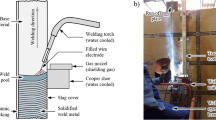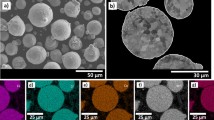Conclusions
-
1.
The average grain size of electric sheet after final annealing varies with the reduction during second cold rolling — with small (insufficient) reductions the grain size remains unchanged, reaches its highest value in the critical range of reductions, and then decreases in the supercritical range.
-
2.
With decreasing average grain size and polygonization the coercive force increases, and therefore the variation of the coercive force with reduction is the reverse of the variation of the grain size with reduction.
-
3.
Low-carbon electric sheet with a coercive force not over 79.8 A/m should be produced by using second cold rolling with not less than critical reduction.
-
4.
With increasing final thickness of the sheet and increasing aluninum concentrations the critical reduction is higher. Increasing the aluminum concentration broadens the range of insufficient reductions, while increasing the thickness broadens the precritical range of reductions.
Similar content being viewed by others
Literature cited
A. I. Belyakov et al., "Effect of treatment on properties of cold rolled low-carbon electric sheet," Trudy TsNIIChM, No. 78, 91 (1971).
R. B. Gutnov et al., Production of Low-Carbon Iron [in Russian], Metallurgiya, Moscow (1973), p. 287.
A. P. Okenko, M. I. Ivanenkov, and M. N. Kul'kova, "Fine precipitates in grain boundaries of electric sheet," Metal. i Term Obrabotka Metal., No. 5, 30 (1971).
S. S. Gorelik, Recrystallization of Metals and Alloys [in Russian], Metallurgiya, Moscow (1967), p. 186.
L. G. Dyikstra, "Relationship of magnetic properties and microstructure", in: Structure of Metals and Properties [Russian translation], Metallurgizdat, Moscow (1957), p. 186.
Additional information
I. P. Bardin Central Scientific-Research Institute of Ferrous Metallurgy. Translated from Metallovedenie i Termicheskaya Obrabotka Metallov, No. 3, pp. 39–43, March, 1976.
Rights and permissions
About this article
Cite this article
Mironov, L.V., Losev, K.F. & Chernobrovkina, L.S. Structure and coercive force of low-carbon electric sheet after second cold rolling. Met Sci Heat Treat 18, 230–233 (1976). https://doi.org/10.1007/BF00663483
Issue Date:
DOI: https://doi.org/10.1007/BF00663483




